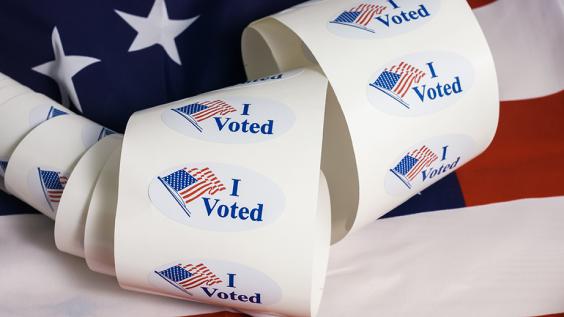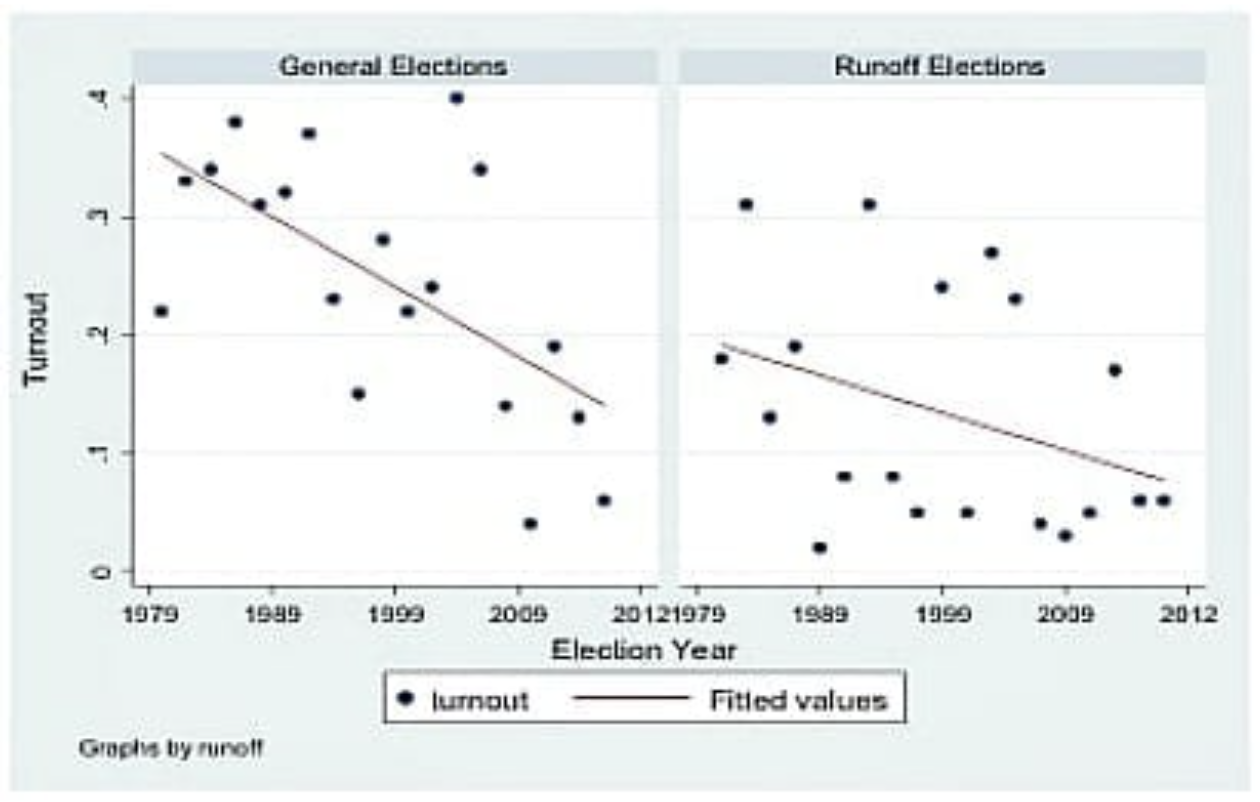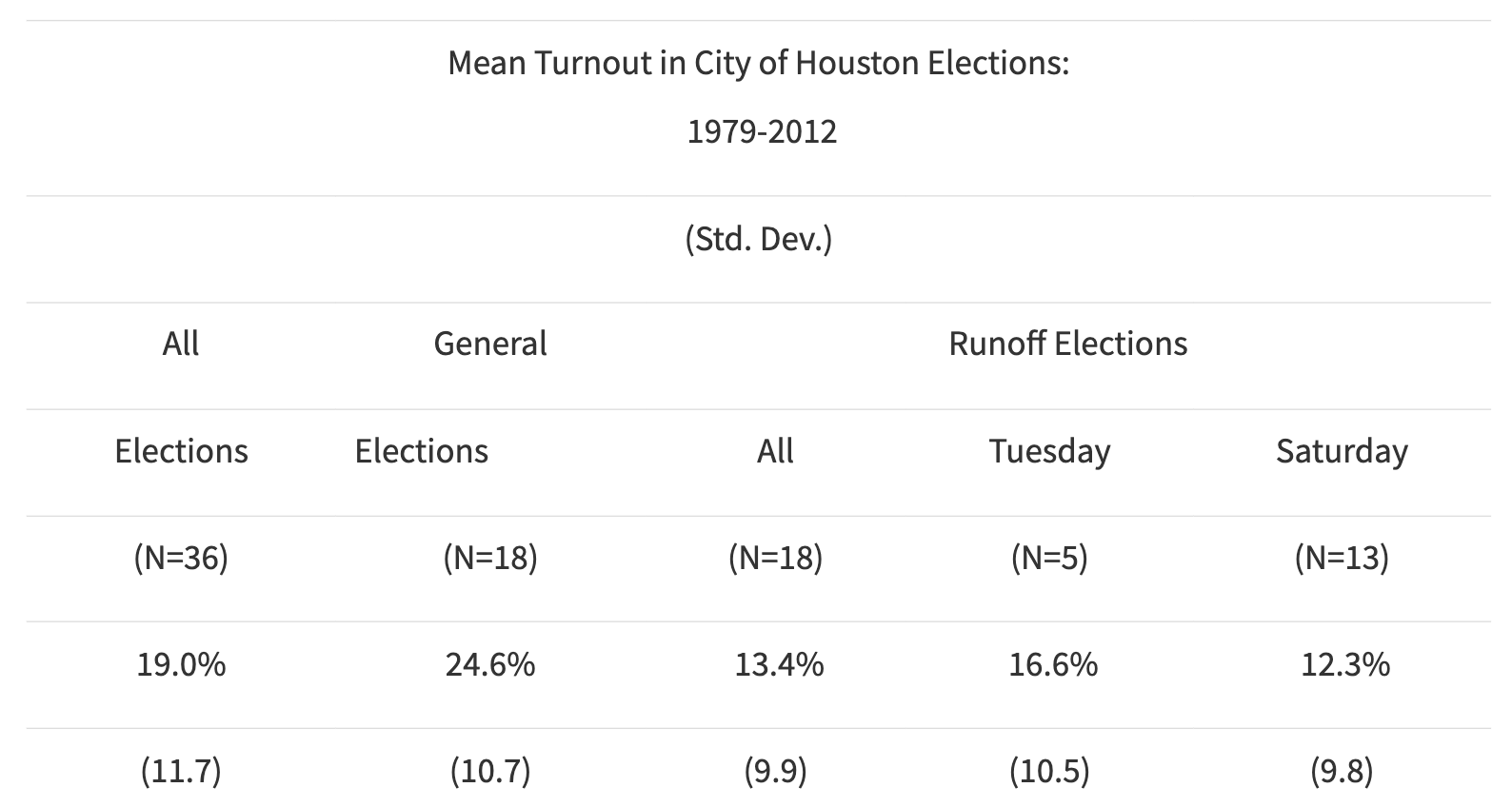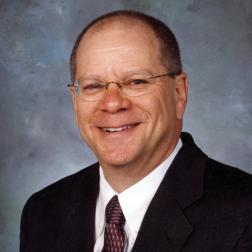Houston’s 2015 Mayoral Election: Voter Turnout and Its Impact

Table of Contents
Author(s)
The current field of announced and likely candidates in the 2015 Houston mayoral race is the largest and strongest in the last 35 years. There are six candidates (former Democratic congressman Chris Bell; councilman Stephen Costello; Harris County Sheriff Adrian Garcia; former Kemah mayor Bill King; councilman Oliver Pennington; state Rep. Sylvester Turner) who currently hold or recently held elective office. A seventh candidate, Ben Hall, has run recently for mayor and has some additional recognition as a former city attorney. These candidates have a record of electoral success in the city as well as a record of significant campaign fund raising. Moreover, there might be other candidates yet unannounced who will enter the race for Houston mayor.
With a large field in the general election, it is certain that a runoff election will be held. Experienced candidates in the general elections are likely to run campaigns aimed at making the runoff. This means candidates, especially those who have previously held elective office, will target their campaign messages to a narrow number of voters who have a history of voting for and supporting a particular candidate. Each candidate will run in the general election to turn out his vote base, and only his vote base.
It is likely to take 21 to 23 percent of the vote cast in the general election to win one of two spots in the runoff election. With 950,000 eligible voters in the city, an expected general election turnout of 20 percent (N=190,000) 40,000+ votes could put a candidate into the runoff. To garner this number of votes, candidates have to find their “loyal supporters” and bring them to the polls without motivating another candidate’s base vote. With early voting and mail voting (for those over 65 and out of the city for the general election), candidates will emphasize amassing their vote well before Election Day 2015.
One might expect that turnout will increase with so many strong candidates in the general election. I doubt this outcome is likely. Candidates seeking to move to the runoff cannot risk mobilizing another candidate’s vote. More importantly, each candidate needs to concentrate on turning out his core/certain supporters. This strategy means most candidates will focus on likely voters who have a history of voting for their candidacy. No one has a strong incentive to turn out unlikely voters since these voters could be persuaded to vote for another candidate or not vote, wasting scarce resources, i.e., money and personnel.
The best financed candidates and those who have effective organizations able to identify and turn out their loyal and likely voters will most likely move forward to the runoff. It also seems unlikely that issues or partisanship will be critical factors in the general election — though this should change in the runoff, depending on which two candidates move forward. I would expect the candidates in the general election to run campaigns directed at frequent and targeted voter contacts, using traditional door-to-door canvassing, extensive social media and very personalized appeals to voters from the candidates. I don’t see a significant incentive for candidates to attack each other in the general election, as this might detract from their efforts to mobilize their base and worse, risk losing supporters in the runoff, should they advance.
Candidate Voter Niches
Several candidates will compete for the same or overlapping core voters. Turner and Hall will each vie for support from African-American voters, especially African-American women over 50 years of age. Bell and Garcia are likely to compete for the substantial Democratic vote, especially the Anglo, LGBT and young progressive voters who anchored Annise Parker’s election victories. As the only Hispanic in the field, Garcia should garner a substantial share of the Hispanic vote, albeit a vote that has not fulfilled its potential in races with strong Hispanic candidates.
Turner has raised significant amounts of money and maintains strong voter identification among likely Houston voters. Hall’s candidacy has the potential to drain a small but important share of the African-American vote from Turner. Turner must also look for support outside the African-American community, most likely from Anglo Democrats and some Republicans. This will be a difficult balancing act, especially with Bell and Garcia competing for Democrats.
Costello, Pennington and King have center-right appeal, especially for Republican, Westside, Kingwood and Clear Lake voters. Only Costello has had success running citywide as a recognized Republican and center-right candidate. However, his close association with the Parker administration may leave an opening for either Pennington, King or another candidate to compete for this largely Anglo, outside-the-loop Republican vote.
Garcia could have broad appeal to several constituencies of likely voters, i.e., Hispanics and Democrats. In addition, he has won two countywide elections for sheriff, winning significant (12 percent) crossover support from Republican voters, although this success appears to be limited to non-city portions of the county. He did not garner a substantial crossover vote in Kingwood, Clear Lake and Westside precincts inside the city.
For Garcia, the key questions are whether he can establish himself as the “Democrat” candidate for mayor and mobilize Hispanic voters. His efforts to establish himself as the prime Democrat in the race maybe thwarted by Bell’s efforts to make the same claim. In addition, Garcia’s only tepid support of the countywide candidates in 2014, most notably Kim Ogg, Democrat for district attorney, may come back to haunt. Moreover, there is evidence that younger Hispanic voters are not motivated by partisan candidate appeals — witness their poor performance for the Democratic ticket in 2014 (i.e., pre- and post-election surveys suggest 45 percent of 18-44 year old Hispanic voters balloted for Greg Abbott while only 34 percent of Hispanic voters over 45 voted for Abbott).
Other Items on the Ballot
There may be several referenda on the ballot to amend the city charter (e.g., term limits and revenue cap) as well as repeal the recently adopted Houston Equal Rights Ordinance (HERO). A jury trial is underway to determine whether the city erred in rejecting a petition to place the repeal of HERO on the November ballot. Whatever the jury’s decision, it will certainly be appealed. If any of these items are on the November ballot they are certain to change the character and possible outcome of the general election. The HERO amendment has the greater potential for widening the field of candidates with the entry of an anti-HERO candidate. Other candidates, notably Turner, King and Costello, may have trouble with this issue, as many of their core supporters have positions on the ordinance at variance with the candidates’ position.
Some Background Facts on Houston Mayoral Elections
- The trend in voter participation in Houston mayoral elections is downward since 1979. This is true for both general and runoff elections and competitive and noncompetitive mayoral contests.
Figure 1 — Voter Turnout (%) in City of Houston Elections: 1979-2013

- Approximately 70 to 75 percent of voter turnout in the 1979 city of Houston municipal election was Anglo. In 2012 the Anglo share of turnout was approximately 55 percent. The African-American share of voter turnout was 20 to 25 percent, Hispanic 10 to 15 percent and Asian 4 percent.
- There was some expectation that turnout might improve with the adoption in 1989 of Saturday runoff city elections. This expectation has not been realized. In fact, turnout for Saturday runoff elections is lower after 1989 than turnout for runoff elections held on Tuesdays before 1989.
Table 1 — Mean Turnout in City of Houston Elections: 1979-2012

Robert Stein is the Baker Institute fellow in urban politics and the Lena Gohlman Fox Professor of Political Science at Rice University.
This material may be quoted or reproduced without prior permission, provided appropriate credit is given to the author and Rice University’s Baker Institute for Public Policy. The views expressed herein are those of the individual author(s), and do not necessarily represent the views of Rice University’s Baker Institute for Public Policy.

